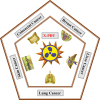The wonders of X-PDT: an advance route to cancer theranostics
- PMID: 39456085
- PMCID: PMC11520131
- DOI: 10.1186/s12951-024-02931-5
The wonders of X-PDT: an advance route to cancer theranostics
Abstract
Global mortality data indicates cancer as the second-leading cause of death worldwide. Therefore, there's a pressing need to innovate effective treatments to address this significant medical and societal challenge. In recent years, X-ray-induced photodynamic therapy (X-PDT) has emerged as a promising advancement, revolutionizing traditional photodynamic therapy (PDT) for deeply entrenched malignancies by harnessing penetrating X-rays as external stimuli. Recent developments in X-ray photodynamic therapy have shown a trend toward minimizing radiation doses to remarkably low levels after the proof-of-concept demonstration. Early detection and real-time monitoring are crucial aspects of effective cancer treatment. Sophisticated X-ray imaging techniques have been enhanced by the introduction of X-ray luminescence nano-agents, alongside contrast nanomaterials based on X-ray attenuation. X-ray luminescence-based in vivo imaging offers excellent detection sensitivity and superior image quality in deep tissues at a reasonable cost, due to unhindered penetration and unimpeded auto-fluorescence of X-rays. This review emphasizes the significance of X-ray responsive theranostics, exploring their mechanism of action, feasibility, biocompatibility, and promising prospects in imaging-guided therapy for deep-seated tumors. Additionally, it discusses promising applications of X-PDT in treating breast cancer, liver cancer, lung cancer, skin cancer, and colorectal cancer.
Keywords: Deep tumors; ROS; Theranostic; X-PDT; X-ray responsive imaging.
© 2024. The Author(s).
Conflict of interest statement
The authors declare no competing interests.
Figures









Similar articles
-
Recent Progress and Trends in X-ray-Induced Photodynamic Therapy with Low Radiation Doses.ACS Nano. 2022 Dec 27;16(12):19691-19721. doi: 10.1021/acsnano.2c07286. Epub 2022 Nov 15. ACS Nano. 2022. PMID: 36378555 Review.
-
Nanoscintillator-Mediated X-Ray Induced Photodynamic Therapy for Deep-Seated Tumors: From Concept to Biomedical Applications.Theranostics. 2020 Jan 1;10(3):1296-1318. doi: 10.7150/thno.41578. eCollection 2020. Theranostics. 2020. PMID: 31938066 Free PMC article. Review.
-
Catalytic nanotechnology of X-ray photodynamics for cancer treatments.Biomater Sci. 2023 Feb 14;11(4):1153-1181. doi: 10.1039/d2bm01698b. Biomater Sci. 2023. PMID: 36602259 Review.
-
Breaking the Depth Dependence by Nanotechnology-Enhanced X-Ray-Excited Deep Cancer Theranostics.Adv Mater. 2019 Mar;31(12):e1806381. doi: 10.1002/adma.201806381. Epub 2019 Jan 30. Adv Mater. 2019. PMID: 30698854 Review.
-
Annealing-modulated nanoscintillators for nonconventional X-ray activation of comprehensive photodynamic effects in deep cancer theranostics.Theranostics. 2020 May 20;10(15):6758-6773. doi: 10.7150/thno.41752. eCollection 2020. Theranostics. 2020. PMID: 32550902 Free PMC article.
Cited by
-
Precision nanomaterials in colorectal cancer: advancing photodynamic and photothermal therapy.RSC Adv. 2025 Jul 25;15(33):26583-26600. doi: 10.1039/d5ra03996g. eCollection 2025 Jul 25. RSC Adv. 2025. PMID: 40727285 Free PMC article. Review.
-
Trends and emerging frontiers of photodynamic therapy for non-melanoma skin cancer (1979-October 2024): a bibliometric analysis.Front Oncol. 2025 Jul 7;15:1580453. doi: 10.3389/fonc.2025.1580453. eCollection 2025. Front Oncol. 2025. PMID: 40692864 Free PMC article.
-
The Role of Reactive Oxygen Species in Colorectal Cancer Initiation and Progression: Perspectives on Theranostic Approaches.Cancers (Basel). 2025 Feb 22;17(5):752. doi: 10.3390/cancers17050752. Cancers (Basel). 2025. PMID: 40075600 Free PMC article. Review.
References
-
- Siegel RL, Miller KD, Fuchs HE, Jemal A. Cancer statistics, 2022. CA Cancer J Clin. 2022;72:7–33. - PubMed
-
- Li X, Ramadori P, Pfister D, Seehawer M, Zender L, Heikenwalder M. The immunological and metabolic landscape in primary and metastatic liver cancer. Nat Rev Cancer. 2021;21:541–57. - PubMed
-
- Oudkerk M, Liu SY, Heuvelmans MA, Walter JE, Field JK. Lung cancer LDCT screening and mortality reduction—evidence, pitfalls and future perspectives. Nat Rev Clin Oncol. 2021;18:135–51. - PubMed
Publication types
MeSH terms
Substances
Grants and funding
LinkOut - more resources
Full Text Sources
Medical

